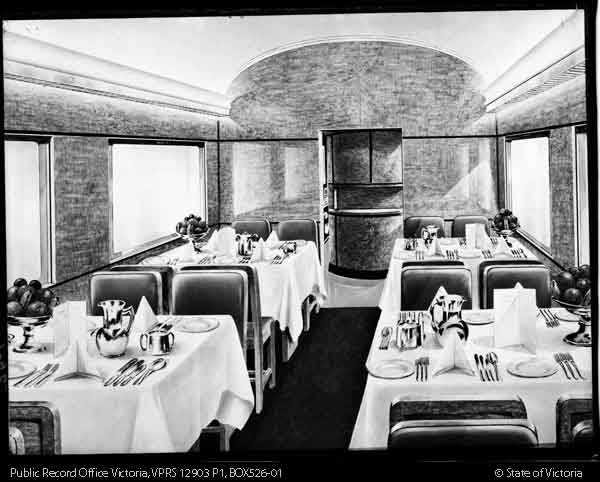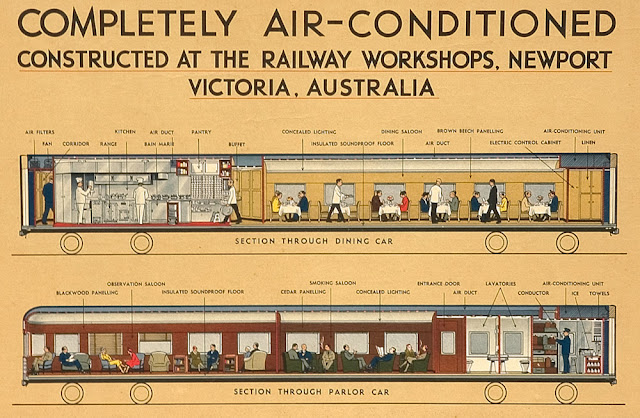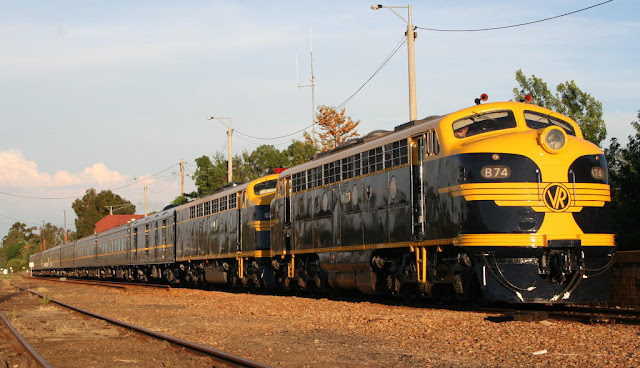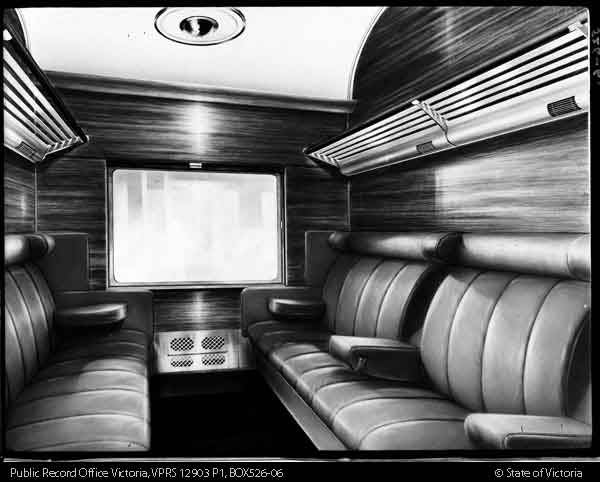The Australian luxury day express train SPIRIT OF PROGRESS was the most important express train of VICTORIAN RAILWAYS, a state corporation of Victoria, and one of the most important trains in Down Under. The train is a masterpiece of ART DÉCO design from Down Under. The widely unknown train was in service from 1937 till 1986. First the SPIRIT OF PROGRESS did run from Melbourne to Albury, because of the broad gauge of VICTORIA RAILWAYS (1,600 mm). At the boarder between Victoria and New South Wales the passengers had to leave the SPIRIT OF PROGRESS and go on with their trip to Sidney on the standard gauged (1, 435 mm) train of the New South Wales Railway system. In 1962 the SPIRIT OF PROGRESS could run straight to Sydney. But was withdrawn in 1986, caused by the lack of paying passengers.
by Earl of Cruise |
| VICTORIAN RAILWAYS S Class steam locomotive 302 EDWARD HENTY trajecting the SPIRIT OF PROGRESS - courtesy © Weston Langford |
The late 1930's saw a new era in Australian rail. And in 1937 the Victorian Government introduced the SPIRIT OF PROGRESS. The train was introduced as an offer for passengers to New South Wales, and Sydney.
The SPIRIT OF PROGRESS introduced a standard of comfort to Australia's rail traffic that previously was unknown. The luxurious offer was preceded by many years of preparation: The track had been equipped with heavier tracks enabling the system carying the much heavier steam locotives than the previously used A2 class (4-6-0) and an improved signalling system. The VICTORIAN RAILWAYS had purchased three-cylinder Pacific locomotives (2-C-1) in 1928, classified as the S Class, which were given a streamlined body and extra-large tenders for the SPIRIT OF PROGRESS. This was necessary for the train being able traveling the approximately 300 km long route without stopping. The average cruising speed was about 75 km/h (52 mph), the maximum speed was almost 100 km/h (60 mph). The SPIRIT OF PROGRESS was then the fastest passenger train in Australia and the one that travelled the longest distance non-stop (306.6 km). This also placed high demands on the heater, which had to shovel six to seven tons of coal onto the grate during a trip. During the train's return journey to Melbourne on the occasion of the opening run on 17 November 1937, he set an Australian speed record on rails between Werribee and Laverton: 128 km/h (79.5 mph). It was not until 1951 that the locomotives were converted to oil-fired and replaced by diesel locomotives from 1952 onwards.
 |
| The Spirit of Progress headed by S301 Sir Thomas Mitchell near Kilmore East in 1938 - Source: Wikipedia |
The SPIRIT OF PROGRESS S Class steam locomotives have been:
S300: MATTHEW FLINDERS
S301: Sir THOMAS MITCHELL
S302: EDWARD HENTY
S303: CJ LA TROBE
S301: Sir THOMAS MITCHELL
S302: EDWARD HENTY
S303: CJ LA TROBE
When introduced, the train featured many innovations new or recently introduced to Australian railway practice, such as streamlining, full air-conditioning, and all-steel carriage construction. Its overall exterior and interior design reflected the latest ART DÉCO style. Interior fittings used materials such as stainless steel and native Australian blackwood veneers. The luxurious new SPIRIT OF PROGRESS also featured a dining car with a modern galley kitchen, modelled after the most up-to-date hospital kitchens of the period and, at the rear, a round-ended parlour/observation car offering panoramic views of the Victorian countryside as it disappeared into the distance.
The last wagon of the train, was a saloon and pulpit - the Parlor car, was the only one with a large compartment (coupé). His use was subject to a surcharge. The Parlor car forced that the train had to be turned at both ends of its runway over a triangle or a reversing loop.
The last wagon of the train, was a saloon and pulpit - the Parlor car, was the only one with a large compartment (coupé). His use was subject to a surcharge. The Parlor car forced that the train had to be turned at both ends of its runway over a triangle or a reversing loop.
 |
| The parlor car of the SPIRIT OF PROGRESS - Source: prov.vic.gov.au (VPRS 12903/P1, item 526/06) |
 |
| The SPIRIT OF PROGRESS press launch with locomotive S302 at Spencer Street station prior to the demonstration run to Geelong on 17 November 1937 - Source: Wikipedia |
Today rail transport in Victoria, is provided by a number of railway operators who operate on the government-owned railway lines. Victorian lines still use 1,600 mm (5 ft 3 in) 1,600 mm broad gauge, with the exception of a number of standard gauge 1,435 mm (4 ft 8 1⁄2 in) freight and interstate lines, a few experimental 762 mm (2 ft 6 in) narrow gauge lines, and various private logging, mining and industrial railways.
Till 1883 the railways were privately owned and operated, until the State Government established then the vertically integrated VICTORIAN RAILWAYS. This remained until corporatisations occurred in the 1980s, followed by privatisation in the 1990s. Passenger services today are operated by METRO TRAINS MELBURNE in suburban Melbourne with electric multiple units, and V/LINE in regional Victoria with diesel trains. Freight services are operated by PACIFIC NATIONAL and other private operators such as El ZORRO, SPECIALIZED CONTAINER TRANSPORT LOGISTICS and AURIZON. After a peak in 1942, the rail network, radiating out of Melbourne into Victoria, it is steadly declining in its length following a swift to road transport.
 |
| S 302 EDWARD HENTY' on SPIRIT OF PROGRESS leaving Albury for Melbourne - © Noel Reed, source: Trams Down Under |
The S class was VR's first three-cylinder locomotive, and Smith's design was influenced by Nigel Gresley's GREAT NORTHERN RAILWAY A1 class 4-6-2 (Pacific) with its Gresley conjugated valve gear. The S class also showed American design influence in its use of a delta trailing truck and bar frames rather than plate frames. Built at Victorian Railways' Newport Workshops,
the S class locomotives were, at the time of construction of the first
three, the largest locomotives to have been built in Australia, and had the largest boilers to have yet been constructed in the southern hemisphere. Another notable design innovation, the incorporation of all three cylinders and the smokebox saddle into a single 5.6 tons (5½ long-ton) casting, was the first of its type in the southern hemisphere and one of the largest single castings yet undertaken in Australia. The superior power of the S Class had a profound impact on the timetable, which in
July 1928 saw a cut of half an hour from the previous five hour,
nineteen-minute northbound SYDNEY LIMITED schedule set for the A2.
By July 1935, the S class locomotives had once again accelerated services. With the line speed limit now raised to 112.7 km/h (70 miles per hour), the S class-hauled SYDNEY LIMITED was reported as the fastest train in the Southern Hemisphere with the southbound service running at an overall average speed of 77.25 km/h (48 miles per hour) including the 5 minute stop at Seymour to take on water. The 208.0 km (129 ¼ mile) non-stop run between Seymour and Albury was also Australia's longest.
By 1931 a severe reduction in passenger traffic caused by the Great Depression saw the S class locomotives withdrawn from running the Sydney express services, and they were put to use on goods trains on the North Eastern line until passenger traffic picked up. As well as allowing Victorian Railways to deflect criticism of its investment in building the S class locomotives.
By July 1935, the S class locomotives had once again accelerated services. With the line speed limit now raised to 112.7 km/h (70 miles per hour), the S class-hauled SYDNEY LIMITED was reported as the fastest train in the Southern Hemisphere with the southbound service running at an overall average speed of 77.25 km/h (48 miles per hour) including the 5 minute stop at Seymour to take on water. The 208.0 km (129 ¼ mile) non-stop run between Seymour and Albury was also Australia's longest.
By 1931 a severe reduction in passenger traffic caused by the Great Depression saw the S class locomotives withdrawn from running the Sydney express services, and they were put to use on goods trains on the North Eastern line until passenger traffic picked up. As well as allowing Victorian Railways to deflect criticism of its investment in building the S class locomotives.
 |
| SPIRIT OF PROGRESS vs Airco DH4 - Source: Wikipedia |
On the initial demonstration run of the SPIRIT OF PROGRESS to Geelong, S302 set an official Australian rail speed record of 127.9 km/h (79.5 miles per hour). While in the context of the British locomotive Mallard reaching a recorded 202.8 km/h (126 mph) on a downhill track the following year the SPIRIT's
speed was unremarkable, the publicity surrounding the launch of the new
streamliner (including footage of the train racing against aircraft)
nevertheless captured the public imagination and was widely reported in
contemporary press and newsreels. Later LNER let the A4 driven train run against a spped boat and too an airplane.
The Mallard´s speed record is quite questionable as the specifications are not the same as DEUTSCHE REICHSBAHN BR05 with 2300 mm driving wheels diameter alone. It should be recognized, that the diameter of the drivers is most relvant for the speed, not only steam pressure and fire box. Further the track when reaching 202 km/h was downhill, while BR05´s track was flat between Berlin and Hamburg, when the steam engine reched 200,5 km/h with a normal express train load 200 t (four coaches). With a 250 t train BR05 reached 195,7 km/h.
The Mallard´s speed record is quite questionable as the specifications are not the same as DEUTSCHE REICHSBAHN BR05 with 2300 mm driving wheels diameter alone. It should be recognized, that the diameter of the drivers is most relvant for the speed, not only steam pressure and fire box. Further the track when reaching 202 km/h was downhill, while BR05´s track was flat between Berlin and Hamburg, when the steam engine reched 200,5 km/h with a normal express train load 200 t (four coaches). With a 250 t train BR05 reached 195,7 km/h.
Three hundred invited guests joined the train for the inaugural run, ranging from Attorney-General of Australia former Railways Minister Robert Menzies to Mr AO Henty, descendant of Edward Henty, the Victorian pioneer after whom the train's locomotive was named. The train reached 119.1 km/h (74 mph) against a headwind on the Down journey to Geelong, and on the return leg reached a new official Australian rail speed record of 79.5 mph (127.9 km/h) between Werribee and at Laverton before speed was cut to avoid stray livestock on an unprotected level crossing.
While not officially acknowledged, the steam-hauled SPIRIT OF PROGRESS is reported on occasion to have reached speeds as high as 138.4 km/h (86 mph) while in regular service. Flaman speed recorder paper tape records were taken for every journey.
While not officially acknowledged, the steam-hauled SPIRIT OF PROGRESS is reported on occasion to have reached speeds as high as 138.4 km/h (86 mph) while in regular service. Flaman speed recorder paper tape records were taken for every journey.
There was never made any official record speed trial with BR05. But never the less, both steam engines were superbe technique and engineering and the best what steam locomotive producer and engineers did construct, beside some other engines.
 |
| Steam locomotive BR05 of DEUTSCHE REICHSBAHN, the streamlined body was removed after WWII - copy from the authors DER NEUE BROCKHAUS, 1938 |
When the Great Depression, caused by the 1929 Wall Street Crash, did slow down in the mid 1930s and passenger numbers rose again, VICTORIAN RAILWAYS saw the time for a new train, that should exceed standard comfort speed on its prestigous route to Alburs.
The new coaches for First and Second Class had been constructed in VR´s own workshop. The coaches have been consructed in steel, mostly riveted but partly welded. This caused a reduction in weight for each coach, despite their luxurious outfittings and incorporated new technologies, as the air conditioning.
The new coaches for First and Second Class had been constructed in VR´s own workshop. The coaches have been consructed in steel, mostly riveted but partly welded. This caused a reduction in weight for each coach, despite their luxurious outfittings and incorporated new technologies, as the air conditioning.
Spirit Of Progress - Australia's Wonder Train 1937
Source: YouTube
Source of the following pictures: prov.vic.gov.au
 |
| SPIRIT OF PROGRESS, the riveting can be seen clearly at the Parlor car |
 |
| SPIRIT OF PROGRESS dining car |
 |
| SPIRIT OF PROGRESS look out lounge of the parlor car |
 |
| VRs SPIRIT OF PROGRESS Poster, 1937, longitudinal cut - courtesy by Percy Trompf |
On 14 July 1952 the VR entered the diesel era, with the delivery of the first B class mainline locomotive, with the commissioning of the first mainline electrification scheme in Australia in July 1954 to Warragul.In the 1960s the break of gauge at Albury was eliminated, with the opening of the North East standard gauge line in 1962. The same year the SOUTHERN AURORA, a First Class sleeper train, was inaugurated.
 |
| The SPIRIT OF PROGRESS led by GM class locomotives in the 1970s - Sources: Wikipedia |
Despite the advantage for the passengers, being no longer forced changing the trains in Albury, because of the new standard gauge line since 1962 between Melburne and Sydney, the passenger numbers declined because of more road traffic, by using cars, and rising airtraffic between the two state capitals. In 1986 came the end of the SPIRIT OF PROGRESS.
In view of declining passenger numbers, both the SPIRIT OF PROGRESS and SOUTHERN AURORA were abandoned on 3 August 1986 and merged to form a night service called Sydney Express or Melbourne Express, depending on the direction of travel. In 1993, this connection was then replaced by an XPT diesel railcar from CountryLink.
The cars in the original Spirit of Progress set have been preserved - with the exception of a car damaged in an accident - and were used by Victoria Rail, its successor V/Line and a private railway company. Some were in operation until at least 2007. Some of the cars are in the care of the Seymour Railway Heritage Centre.
The cars in the original Spirit of Progress set have been preserved - with the exception of a car damaged in an accident - and were used by Victoria Rail, its successor V/Line and a private railway company. Some were in operation until at least 2007. Some of the cars are in the care of the Seymour Railway Heritage Centre.
 |
| B74 hauling the 70th anniversary SPIRIT OF PROGRESS in Benalla November,25th 2007 - Source:Wikipedia |
After the demise of sleeper trains in the early 1990s, many of the carriages passed to the Australian Railway Historical Society, Canberra and New South Wales Rail Transport Museum who have maintained them in operational condition. The latter often operates them on tours under the SOUTHERN AURORA banner.
Much of the original SPIRIT OF PROGRESS rolling stock remained in use on regular long distance intrastate service for VR and its successor V/Line, and for a period of time the private rail operator West Coast Railway. It is perhaps a measure of the high standard of the SPIRIT OF PROGRESS rolling stock that the last of the "BS" class of compartment cars was only retired by V/Line in July 2006, almost 69 years after their introduction, and with a boom in V/Line
patronage a set comprising five BS carriages was re-introduced to
service from September 2007 before being withdrawn in August 2010.
Literature:
Ian Brady:
The Blue. The Story of the Spirit of Progress = Australian Railway History
(Bulletin of the Australian Railway Historical Society) Bd. 58, Nr. 841
(November 2007).
John
Buckland: Half a Century of Spirit of Progress. In: Australian Railway
History (Bulletin of the Australian Railway Historical Society). November 1987,
S. 241–247.
Dale Butt:
The First Standard Gauge Spirit of Progress: April 1962. Australian Railway
History (Bulletin of the Australian Railway Historical Society). April 2002, S.
125–135.
Brian
Carroll: Australia's railway days: milestones in railway history. 1976. ISBN 0-333-21055-7
Dunn u.a.: Super
Power on the VR = Train Hobby Publications. 2006. ISBN 1-876249-94-3
Robert Lee: The
Railways of Victoria 1854-2004. Melbourne 2007.
Pearce u.a.:
North Williamstown Railway Museum. Melbourne 1980. ISBN 0-85849-018-8
Heading along the wrong track
Spirit of Progress celebrates80th anniversary with tour
Heritage - ORIENT EXPRESS living legend
History - RHEINGOLD the German luxury day express
Wongm´s Rail Gallery

SPIRIT OF PROGRESS in promotion broshure of VICTORIAN RAILWAYS





Australia is racist like U. S. We’re aboriginal and blackbpeople allowed to ride this train?
ReplyDeleteGreat article on the Spirit of Progress. I have been unable to work out which stations it traveled through on its way out of Melbourne. Did it actually pass through Glenroy and Broadmeadows on its way north or did it go on the Coburg line ?
ReplyDeleteWow, cool post. I'd like to write like this too - taking time and real hard work to make a great article... but I put things off too much and never seem to get started. Thanks though. Bus Planning
ReplyDeleteI remember dining as a child during WW2 on the Spirit of Progress. The luxury stays in my mind.
ReplyDelete